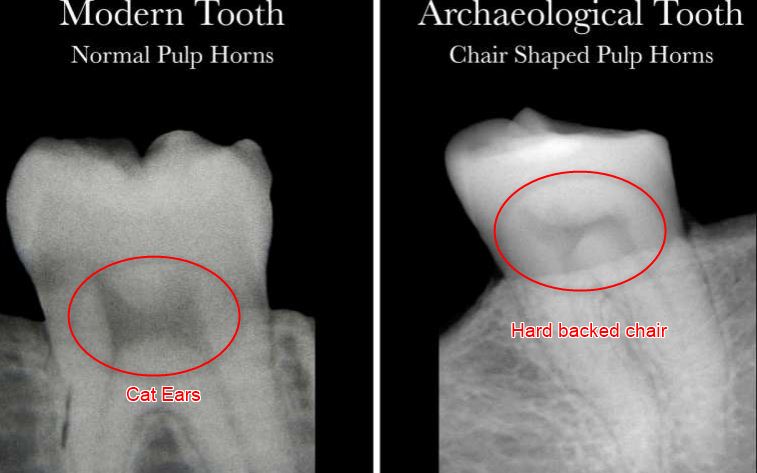Vitamin D deficiency indicated by pulp tooth shape (X ray)
Science meets archaeology with discovery that dental X-rays reveal Vitamin D deficiency Phys.org
Reporting on study in International Journal of Paleopathology.
The rachitic tooth: The use of radiographs as a screening technique, online 7 November 2017
Lori D’Ortenzio | Isabelle Ribot | Bonnie Kahlon | Benoit Bertrand | Emmy Bocaege | Emeline Raguin | Annabelle Schattmann | Megan Brickley
- “The pulp shape in a healthy person's tooth resembles an arch topped by two cat ears, while the pulp shape of a person who has had a severe deficiency of Vitamin D is asymmetrical and constricted, and typically looks like the profile of a hard-backed chair.”

Abstract
This study investigates morphological changes in pulp chambers of living and archaeological individuals with past vitamin D deficiency. Living individuals (n = 29), four with detailed medical and dental records and three groups of archaeological individuals (n = 25) were radiographed; selected individuals were further evaluated histologically for the presence of incremental interglobular dentin (IIGD), indicative of deficiency (28 living; 17 archaeological). Measurements of pulp horns/chambers from radiographs were conducted to quantify morphological observations. One group had clear skeletal evidence of rickets from St. Matthew, Quebec (n = 1) and St. Jacques, France (n = 4); a second group had slight skeletal indicators from Bastion des Ursulines, Quebec (n = 6); and a third group lacked both skeletal and radiological evidence of deficiency from St. Antoine (n = 6) and Pointe-aux-Trembles (n = 4). Results showed archaeological individuals with clear and slight skeletal evidence of past deficiency displayed constricted or chair shaped pulp horns. Living individuals with deficiency exhibited similar pulp chamber morphology. Radiographic pulp horn/chamber measurements corroborated morphological findings and significant differences were found in pulp horn/chamber measurements between those with and without deficiency. Results suggest that radiograph assessment of teeth can be used as a screening technique to elucidate patterns of deficiency and select individuals for microCT or histological assessment.


https://doi.org/10.1016/j.ijpp.2017.10.001 Publisher wants $32 for the PDF
📄 Download the PDF from ResearchGate via Vitamin D Life
This is the first report I am aware of.
Wonder if it will be confirmed.
Pulp shape might also be a function of:
Magnesium
Vitamin K
Protein
Vitamin D deficiency only at a particular age (young?)
- etc.
See also Vitamin D Life
Paleopathology – Vitamin D and bones, teeth during the past 2,000 years – meeting April 2017
Teeth from 19th century London indicate that most children were Vitamin D Deficient - Oct 2019
10 Most-visited pages in Dental category in Vitamin D Life
{LISTPAGES}
